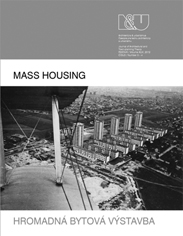THREE TENSES: MASS-HOUSING IN CONTEMPORARY ART
THREE TENSES: MASS-HOUSING IN CONTEMPORARY ART
Author(s): Carmen PopescuSubject(s): Cultural Essay, Political Essay, Societal Essay
Published by: Historický ústav SAV, v. v. i.
Keywords: mass-housing; modernism; communism; artist; contemporary; image; history; rehabilitation
Summary/Abstract: Art Looks at Mass-housing Mass-housing has become an oft-employed motif in the art of the last decades: photographs, videos, installations, movies, and literature have all made a significant place for the urbanity represented by large prefabricated housing blocks. Revealed or transfigured through the artistic gaze, mass-housing conveys a series of questions about politics, society and, ultimately, about life itself. It might seem surprising that an architecture which was decried for different reasons – the scarcity of its aesthetics and of its materials, its monotony both in terms of facades and of public space, its lack of privacy, etc. – has been turned into an artistic motif. One might think that looking at mass-housing came with the particular interest that artists manifested for modernist architecture. What artists were seeking here was not the formal attraction – the ‘nostalgia for its innocent purity of language’, as one argument of an exhibition on modernism put it – but the understanding of its principles. Gazing into this mechanics is fascinating, because more than an expression of (modernist) architecture, Mass-housing is a symptom of modernity itself. The interest for neighborhoods of towers and slabs of concrete developed in the same time with a sensibility for the ordinariness, paralleled by a strong concern for the political and the social. Lefebvre or Baudrillard (and later de Certeau), on the one hand, or Dan Graham, Robert Smithson or Gordon Matta-Clark, on the other, were inspirational for many of those working with the subject of mass-housing today. With the fall of the Berlin Wall, the thousands of districts of mass-housing naturally became the focus of attention both as an emblem of life under socialism and an embodiment of ordinariness. Given the scale, and for some, the rhetorics of the language, their anonymous monumentality was closer to Matta-Clark’s‘nonumentality’, the term he forged for describing ‘commonplaces’. Parallel to this interest in the ordinary (and also as a consequence of it), the artistic motif underwent a certain ‘democratization’. In Cyprien Gaillard’s Geographical analogies (2006 – 2009), there is no hierarchy among the images composing the invariable lozenges, where housing estates rub shoulders with ‘noble’ motifs (historical edifices, funeral monuments, sculptures, landscapes); meanwhile in the series Belief in the Age of Disbelief (2005), towers and slabs enjoy lush, picturesque seventeenth century-like landscapes. Through this democratization of the subject, contemporary art enacts a reassessment of both history and modernity as projects. The questions raised through this process go beyond postmodern aesthetics (to which they are clearly related) by addressing the realm of the political. If working with architectural themes is presented in many cases as a manner of questioning modernism as utopia, then making art out of mass-housing could be seen as something more than ripping...
Journal: Architektúra & Urbanizmus
- Issue Year: 46/2012
- Issue No: 3-4
- Page Range: 302 - 321
- Page Count: 20
- Language: English

